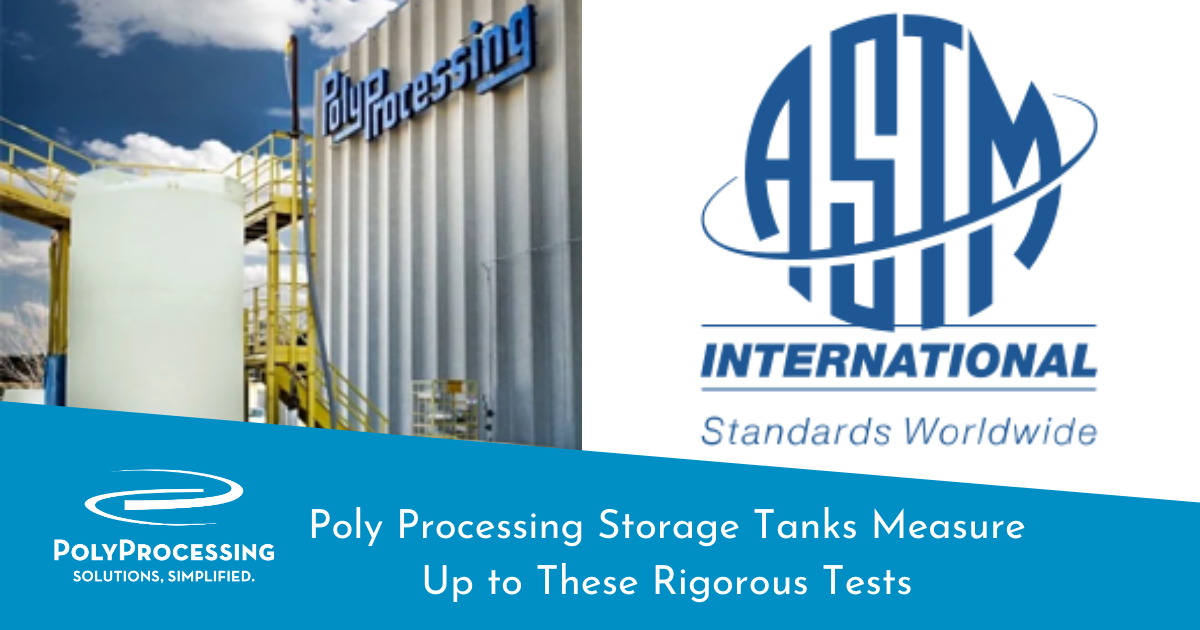Poly Processing Storage Tanks Measure Up to These Rigorous Tests
It’s hard to judge, with the naked eye, how a polyethylene tank is constructed. On the surface, a tank is just a tank. However, there is a big difference between a well-designed, properly constructed tank and a cheap one that doesn’t meet structural requirements.

Not all tank manufacturers follow ASTM D-1998 standards. The ASTM D-1998 standard is set up by the American Society for Testing and Materials to ensure that tanks are built and tested to a recognized standard.
4 ASTM D-1998 Tests
ASTM standards require that many polyethylene tanks and tank materials go through three tests to measure:
- The consistency in the tank’s walls
- The amount of impact the tank can withstand
- The structural integrity of the tank as a whole
There’s also an additional test for cross-linked polyethylene (XLPE) tanks to measure the chemical makeup of the tank materials.
Poly Processing measures many of the tanks we manufacture to ensure that it passes all four tests based on the requirements of ASTM. We calibrate the testing devices every morning before each shift to guarantee that the readings are not only consistent, but accurate.
Let’s take a look at each of the tests and what they mean for your chemical storage tank. As you’ll see, Poly Processing doesn’t simply meet ASTM standards, in some cases we exceed them.
Ultrasonic test: wall thickness
The ultrasonic test is performed to ensure a consistent wall thickness around the entirety of the polyethylene chemical storage tank. Variations in thickness are potential weak spots for tank failure.
This test incorporates an ultrasonic instrument that sends out measurable sound waves. By measuring the time it takes for the waves to travel back, we can calculate the wall depth and verify if it is consistent throughout the tank. We can do this test at various points around the diameter of the chemical storage tank, all the way up the tank wall if it is required.
Impact test: structural integrity
A sample of the tank’s material is taken, usually from holes where fittings will be placed, and tested for structural integrity. The sample material is frozen overnight at -20 degrees Fahrenheit, then placed into a machine where a “dart” is dropped at a certain foot-pound to create the appropriate impact for testing. There are various calculations to determine the required impact. The thicker the tank material, the higher the impact.
This test is administered to verify the tank material can withstand mechanical stress and other challenges associated with long-term chemical storage.
Hydrostatic test: internal pressure
In this test, the tank is filled to the dome with water. ASTM requires that it sits for 30 minutes to verify that there are no leaks and the tank can withstand the hydrostatic weight of the water. Poly Processing’s internal standard is to let the tank sit for at least an hour, but it is common for some of our customers to request a 4-hour or 24-hour hydro test.
This test is performed on the tank as a whole, not just a sample. It not only measures the tank’s ability to withstand hydrostatic pressure, but it tests the fittings and gaskets as well.
Gel test: cross-linking
Performed only on cross-linked polyethylene tanks, the gel test measures the percentage of cross-linking in the wall itself. A sample of the tank material is weighed, then placed in boiling xylene, which breaks down the linear polyethylene, the base material of the resin. All that is left is the cross-linked materials. The sample is weighed again and the difference is calculated to determine the percentage of cross-linking.
To meet ASTM standards, a tank must be at least 60% crosslinked polyethylene. If the gel percentage is too high though, it creates a brittle material. Since some chemicals can only be stored in cross-linked polyethylene tanks, it is critical that the tank’s crosslink percentage hits that sweet spot of 60% to 70%.
At Poly Processing, we manufacture all of our tanks that are required to meet ASTM D-1998 standards to those standards and test to make sure they do. In fact, we strive to exceed expectations to ensure that all of our tanks provide the best chemical storage applications in the industry.
To learn more about the ASTM D-1998 tests our polyethylene chemical storage tanks go through, download the ASTM D 1998 Technical Bulletin.
"ASTM logo" by Anonymous - Licensed under [CC-BY-SA-3.0] via Wikimedia Commons
- January 18, 2021
- Topics: Certifications and Standards
About Poly Processing
Posts By Topic
Tech Talk Podcast Episodes
Subscribe By Email
Recent Posts
- The Best of 2025 - Top 5 Chemical Storage Blogs
- Installation Tips for Chemical Storage Tanks: Site Preparation and Offloading
- Understanding pH and Chemical Concentration When Choosing a Chemical Tank
- Maximizing Fill Efficiency: Selecting the Optimal Fill Line System
- Chemical Storage Tanks: A Quick Guide for End Users
Tank Configurator

Find the recommended tank and system components for your chemical storage challenge.
Configure a Tank Package



